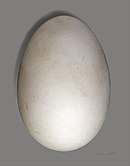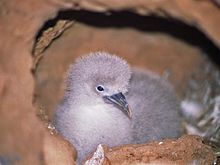Wedge-tailed shearwater
| Wedge-tailed shearwater | |
|---|---|

| |
| Pair "singing", Lady Elliot Island, Queensland, Australia | |
| Scientific classification | |
| Domain: | Eukaryota |
| Kingdom: | Animalia |
| Phylum: | Chordata |
| Class: | Aves |
| Order: | Procellariiformes |
| Family: | Procellariidae |
| Genus: | Ardenna |
| Species: | A. pacifica
|
| Binomial name | |
| Ardenna pacifica (Gmelin, JF, 1789)
| |

| |
Nonbreeding Breeding
| |
| Synonyms | |
|
Procellaria pacifica ( protonym )
Puffinus pacificus
| |
The wedge-tailed shearwater (Ardenna pacifica) is a medium-large
Taxonomy
The wedge-tailed shearwater was
Description

The wedge-tailed shearwater is the largest of the tropical shearwaters. The two colour morphs of the species are dark and pale; the pale morphs predominate in the North Pacific, the dark morph elsewhere. However, both morphs exist in all populations, and bear no relation to sex or breeding condition. The pale morph has grey-brown plumage on the back, head, and upper wing, and whiter plumage below. The darker morph has the same dark grey-brown plumage over the whole body. The species' common name is derived from the large, wedge-shaped tail, which may help the species glide. The bill is dark and legs are salmon pink, with the legs set far back on the body (in common with the other shearwaters) as an adaptation for swimming.
This species is related to the pan-Pacific Buller's shearwater, which differs much in colour pattern, but also has a wedge tail and a thin, black bill.
Behaviour and ecology
Food and feeding
Wedge-tailed shearwaters feed
Breeding

The wedge-tailed shearwater breeds in

Wedge-tailed shearwaters are
Both sexes undertake a prelaying exodus to build up energy reserves; this usually lasts around 28 days. A single egg is laid, if that egg is lost, then the pair will not attempt another that season. After laying, the male usually undertakes the first incubation stint. Both sexes incubate the egg, in stints that can last up to 13 days. Incubation takes around 50 days. After hatching, the chick is brooded for up to 6 days, until it is able to
Known breeding colonies include:
- Pacific Missile Range Facility, Kauai, Hawaii
- Heron Island, Australia
- Lady Elliot Island, Australia
- Lady Musgrave Island, Australia
- Lord Howe Island, Australia
- Montague Island, Southern New South Wales, Australia
- North West Island, Australia
- Muttonbird Island, Coffs Harbour, Northern New South Wales, Australia
- Mānana Island, Hawaii, United States
- Maui, Hawaii, United States
- Mokuauia Island, Hawaii, United States
- Kupikipiki’o Pt., Hawaii, United States
- Ilot Maitre, Noumea, New Caledonia
- Round Island, Mauritius
- CNMI
- San Benedicto Island, Revillagigedo Islands, Mexico
- Alphonse Island, Republic of Seychelles
- Bijoutier Island, Republic of Seychelles
Gallery
-
Profile in flight, Hawaiian Islands
References
- . Retrieved 13 November 2021.
- ^ Gmelin, Johann Friedrich (1789). Systema naturae per regna tria naturae : secundum classes, ordines, genera, species, cum characteribus, differentiis, synonymis, locis (in Latin). Vol. 1, Part 2 (13th ed.). Lipsiae [Leipzig]: Georg. Emanuel. Beer. p. 560.
- ^ Latham, John (1785). A General Synopsis of Birds. Vol. 3, Part 2. London: Printed for Leigh and Sotheby. p. 416, No. 22.
- ^ Mayr, Ernst; Cottrell, G. William, eds. (1979). Check-List of Birds of the World. Vol. 1 (2nd ed.). Cambridge, Massachusetts: Museum of Comparative Zoology. p. 91.
- ^ Mathews, Gregory M. (1912). The Birds of Australia. Vol. 2. London: Witherby. p. 80.
- ^ Hellmayr, C.E.; Conover, B. (1928). Catalogue of Birds of the Americas and the Adjacent Islands in Field Museum of Natural History. Field Museum Natural History Publication 242. Zoological Series. Volume 13, Part 1 No. 2. p. 66, Note.
- ^ Reichenbach, H. G. Ludwig (1853). Avium systema naturale. Dresden and Leipzig: Expedition der vollständigsten naturgeschichte. p. IV. The title page has 1850 (original title page missing in the BHL scan but available from BSB). The Preface is dated 1852 but Mayr 1979 gives the year as 1853.
- ^ Rasmussen, Pamela, eds. (August 2022). "Petrels, albatrosses". IOC World Bird List Version 12.2. International Ornithologists' Union. Retrieved 15 November 2022.
- hdl:2445/193747.
- PMID 8812308.
- .
- doi:10.1071/MU01060.
- ^ "Proposal (647) to South American Classification Committee: Split Ardenna from Puffinus". South American Classification Committee. Retrieved 23 January 2016.
- .
Further reading
- Congdon, BC; Krockenberger, AK; Smithers, BV (2005). "Dual-foraging and co-ordinated provisioning in a tropical Procellariiform, the wedge-tailed shearwater". Marine Ecology Progress Series. 301: 293–301. .
External links
- BirdLife species factsheet
- California Bird Records Committee: Rare bird photos – wedge-tailed shearwater
- USFWS, Midway Atoll NWR: Wedge-tailed shearwater
- Frank O'Connor's Birding Western Australia: More photos of the wedge-tailed shearwater



